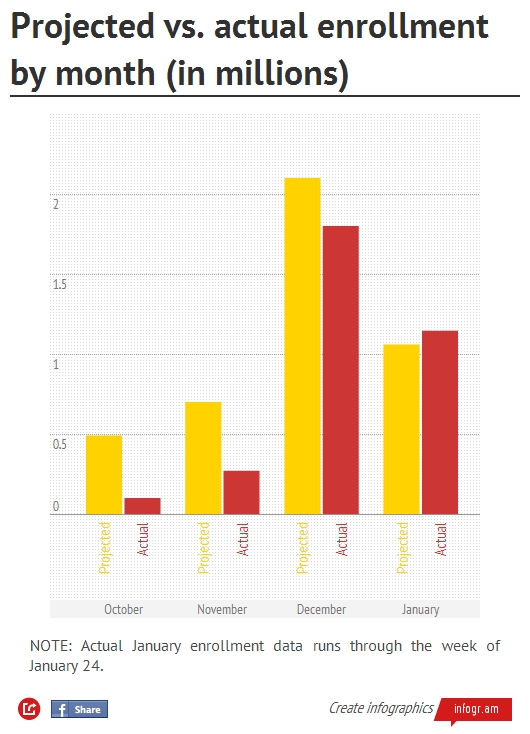In fact, January sign-ups exceeded expectations:
The latest enrollment data from the Obama administration show that 3.3 million people have signed up for private health insurance through federal and state insurance exchanges created under the Affordable Care Act. This figure represents all enrollment from Oct. 1 through Feb. 1. It includes both people who have and have not paid their first month’s premium. Of those people, 1,146,100 selected their health insurance plans in January, meaning there was a 53 percent increase enrollment last month alone.
This makes January the first month that the Obama administration has beaten an enrollment target. Back in September, way before HealthCare.gov’s botched launch, the Centers for Medicare and Medicaid Services projected that 1,059,900 people would sign up for private health insurance in January. However, the Obama administration still falls short of projected, cumulative enrollment by 1 million people, largely due to the anemic sign-ups in October and November.
Benen sees the numbers as evidence that the system is stabilizing. Sprung worries that only those who qualify for subsidies seem to be signing up:
Fully 82% of the 3.3 million people who have selected a marketplace plan are eligible for subsidies. That would be 2.49 million. Overall, 7.27 million people have been determined eligible to enroll in a marketplace plan. Of those, 4.16 million, or 57%, are eligible for subsidies. 60% of them (2.49 out of 4.16) have pulled the trigger and selected a plan Of the 3.11 million who have completed applications and been found ineligible for subsidies, just 594,000 — again, 19% — have enrolled in plans.
The low signup rate thus far for the subsidy-ineligible is perhaps unsurprising. Unsubsidized insurance on the exchanges is expensive. In New Jersey, a single 27 year-old earning a bit over $32,000 will pay $249 per month for the cheapest silver plan; two 60 year-olds earning $63,000 will pay $1,346 per month. Perhaps many of the unsubsidized will sign up near the deadline; perhaps a significant percentage have bought insurance off the exchanges.
Cohn looks at the big picture:
We don’t know how many of these people have paid premiums. We don’t know how the demographics compare to what insurers had expected. And we don’t know how many of these people had insurance previously. Those are some pretty big unknowns.
But on that last point, at least, we have one more, very small hint that the law is making real progress. It comes from Gallup, which regularly polls on the question of whether people have insurance. According to its latest round of polling, which includes 19,000 survey responses between January 2 and February 2, the proportion of Americans without health insurance has fallen to 16 percent—lower than it was in the first quarter of 2013 and lower than its been anytime since Obama first took office.
Sargent talks to Kaiser’s Larry Levitt about those Gallup numbers:
“It’s an early possible sign of success,” Levitt told me. “There’s been a lot of uncertainty about the affect the ACA is having on the number who are uninsured. Clearly people are signing up, and clearly Medicaid coverage is expanding. But many had their policies canceled. This is the first sign that the net of all that is still likely a decrease in the number of uninsured — it may be moving in the right direction.”
Still, Levitt added: ”I would emphasize that it’s noisy.”
Philip Klein points out the huge discrepancies in enrollment from state to state:
In 11 states including Connecticut, Rhode Island, New York, Maine and New Hampshire, signups are more than 100 percent of projected enrollments. On the other hand, in 13 states signups are tracking at less than 50 percent of original targets.
Though supporters of the health care law have tried to point fingers at Republican states for trying to sabotage enrollment efforts, the worst-performing states were among those that were most gung-ho about implementing the law, including Massachusetts, Oregon, Maryland and the District of Columbia.
If these numbers hold up, the could lead to some interesting decisions for insurers, who may try to back away from exchanges in states that haven’t proved viable, while increasing the number of carriers offered in other states.
Matthew Herper thinks the ACA is looking less and less repealable:
The point is that even with all the law’s problems, there may be a substantial number of people who come to depend on it before there is any political chance of repealing it — before the midterm elections. A more likely outcome than repeal, [Austin] Frakt believes, will be that Republicans, or the government as a whole, will eventually find a way to give more freedom to the states to change some of the parameters of the ACA, bringing states that have resisted marketing their own exchanges or enrolling patients in Medicaid into the fold. Says Frakt: “It may be a conservative means to a progressive ends.”
Even Obamacare critic Avik Roy admits there won’t be a “death spiral” at this rate:
In some quarters, there has been a kind of intellectual laziness, a belief that there’s no need for critics to come up with better reforms, because Obamacare will “collapse under its own weight,” relieving them of that responsibility.
Obamacare isn’t good for the country. But it’s not going to collapse.
